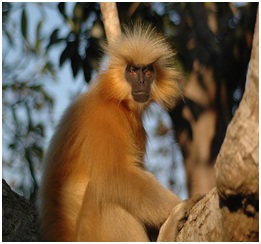

Context
Neighbours of a golden langur habitat in western Assam’s Bongaigaon district have opposed a move by the State government to upgrade it to a wildlife sanctuary.
About
The Species
- Gee's golden langur (Trachypithecus geei), also known as simply the golden langur, is an Old World monkey found in a small region of Western Assam, India and in the neighboring foothills of the Black Mountains of Bhutan.
- Long considered sacred by many Himalayan people, the golden langur was first brought to the attention of the western world by the naturalist Edward Pritchard Gee in the 1950s.
- Adult males have a cream to golden coat with darker flanks while the females and juveniles are lighter.
- It has a black face and a long tail up to 50 cm (19.69 in) in length.
- It lives in high trees and has a herbivorous diet of ripe and unripe fruits, mature and young leaves, seeds, buds and flowers.
- The average group size is eight individuals, with a ratio of several females to each adult male.

|
Species Specification |
|
|
KINGDOM |
Animalia |
|
PHYLUM |
Chordata |
|
SUBPHYLUM |
Vertebrata |
|
CLASS |
Mammalia |
|
ORDER |
Primates |
|
SUBORDER |
Haplorhini |
|
INFRAORDER |
Simiiformes |
|
FAMILY |
Cercopithecidae |
|
GENUS |
Trachypithecus |
|
SPECIES |
Trachypithecus geei |
Background
- Kakoijana Reserve Forest is one of the better-known homes of the golden langur (Trachypithecus geei) found only in Assam and Bhutan and a Schedule-I species under the Wildlife Protection Act of 1972.
- It is listed as among the world’s 25 most endangered primates.
- The Assam Forest Department had in January issued a preliminary notification for converting the 19.85 sq. km. patch of forest into the Kakoijana Bamuni Hill Wildlife Sanctuary.

